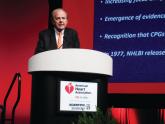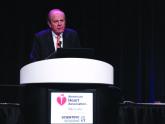Conference Coverage

VIDEO: U.S. hypertension guidelines reset threshold to 130/80 mm Hg
ANAHEIM, CALIF. – Thirty million Americans became hypertensive overnight.
In mid-November, the American College of Cardiology, the American Heart Association, and nine other collaborating societies released a new and long-anticipated guideline for diagnosing and managing hypertension. The top-line, seismic change that the new guidelines called for – treating many patients with hypertension to a blood pressure below 130/80 mm Hg – rubbed the primary care community the wrong way, as described in Part 1 of this feature.
But the novel steps the guideline calls for, from including more careful and methodical measurement of BP, both in and out of the office, to increased reliance on lifestyle interventions, running a formal calculation to identify patients who warrant drug treatment, to a team approach to management, seem to dovetail nicely with the broader goals of primary care.
Part 2 of this feature explores how the approach to diagnosis and management of hypertension spelled out in the ACC/AHA guidelines fits into the protocol-driven, data-monitored, team-delivered primary care model that has come to dominate U.S. primary care in the decade following passage of the Affordable Care Act.
Regardless of what individual primary care physicians (PCPs) and other physicians and clinicians decide about the appropriate BP treatment target for hypertensive patients, their decisions these days are often strongly influenced by the standards set for population levels of BP control by the Centers for Medicare & Medicaid Services and other payers. In a trend traced by experts to the Affordable Care Act of 2009, many payers now emphasize value-based reimbursements and incentives based on health care organizations meeting performance-metric goals. One of the most common goals measured today in primary care is the percentage of patients with hypertension treated to a particular BP target that today is most commonly set as less than 140/90 mm Hg.
The “vast majority” of PCPs now work in practices that are subject to performance targets including levels of BP control, said Romsai T. Boonyasai, MD, an internist at Johns Hopkins Medicine in Baltimore who specializes in quality improvement research in hypertension and other chronic diseases and also works as a PCP.
“At some point, this [the ACC/AHA blood pressure treatment target] will be a performance metric and will determine the resources that my practice and the folks I work with have to take care of patients. If the [metric] is just aggressive enough then we will probably try to achieve it to keep up with our peers. If the quality metric asks us to achieve 70% of patients at less than 130/80 mm Hg instead of less than 140/90 that will make us more aggressive. If the metric changes, we will try to achieve that overall, but we’ll still make exceptions. If I have some patients for whom I don’t think it will be safe, I won’t let a quality metric drive me. I’ll still make exceptions. But what we’ll do is get more patients to below this level. Not every single patient, but more than currently,” Dr. Boonyasai said in an interview.“If HRSA [Health Resources & Services Administration] and CMS set a blood pressure goal of less than 130/80 it would drive adoption. It would make a difference; it would make change come faster,” predicted Saint Anthony Amofah, MD, an internist and chief medical officer of Community Health of South Florida, a health care organization in Miami.
ANAHEIM, CALIF. – Thirty million Americans became hypertensive overnight.

Systems of care, like the VA and Kaiser Permanente, are reaching hypertension control rates of more than 90%.

